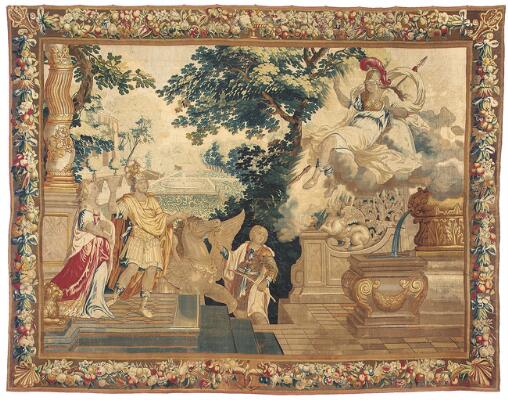A late 17th century Brussel tapestry. “The wedding of Perseus and Andromenda” on the terrace, surrounded by a wide border of fruits, flowers, leafs and bows. 385×300 cm.
In Greek mythology the legend tells that on the way back to Seriphos, Perseus stopped in the Phoenician kingdom Ethiopia, ruled by King Cepheus and Queen Cassiopeia. Cassiopeia, having boasted herself equal in beauty to Aphrodite, drew down the vengeance of Poseidon, who sent an inundation on the land and a sea-monster, Ceto, which destroyed man and beast. The oracle of Ammon having announced that no relief would be found until the king exposed his daughter Andromeda to the monster, she was fastened to a rock on the shore. Here Perseus, returning from having slain the gorgon, found her, slew the monster, and set her free. Perseus married Andromeda in spite of Phineus, to whom she had before been promised. At the wedding a quarrel took place between the rivals, and Phineus was turned to stone by the sight of the Gorgon's head. Andromeda followed her husband to Tiryns in Argos, and became the ancestress of the family of the Perseidae through the son of Perseus and Andromeda, Perses. After her death she was placed by Athena amongst the constellations in the northern sky, near Perseus and Cassiopeia.
Biography: Danae (daughter of Acrisius, King of Argos)was childless and to keep her so, Acrisius shut her up in a bronze chamber underground: this mytheme is also connected to Ares, Oenopion, Eurystheus. Zeus came to her in the form of a shower of gold, and impregnated her. Soon after was born their child Perseus.
Perseus, the legendary founder of Mycenae and of the Perseid dynasty there, was the first of the mythic heroes of Greek mythology whose exploits helped establish the hegemony of Zeus and the Twelve Olympians in the mainland of Greece. Perseus was the hero who killed Medusa.
Andromeda was the daughter of Cepheus and Cassiopeia, king and queen of the Phoenician kingdom Ethiopia.
The collection of Ole Olsen(1864–1843) was of international museum standard and the most comprehensive antique collection of danish history.
Provenance: The collection of genaraldirector Ole Olsen
The collection of Ingerlise Jensen and Guy Badse 1944–2005.
Literature: Hermann Schmitz: “Generaldirektør Ole Olsesns Samlinger”, Bind 1, page 103 (Cat. 1128)
Mentioned with picture in the article of the danish antique magazine: Antik & auktion. - 2004, nr. 4. page 53. “Fyldt med fortællinger”. Antik & Auktion. -2006, nr. 6. page 57. “Den store kunstsamler”.
The tapestry was sold at the auction: The collections of Ole Olsen. Winkel & Magnussen, 1944. Part II lot. 635.
Oriental carpets, 26 April 2007
